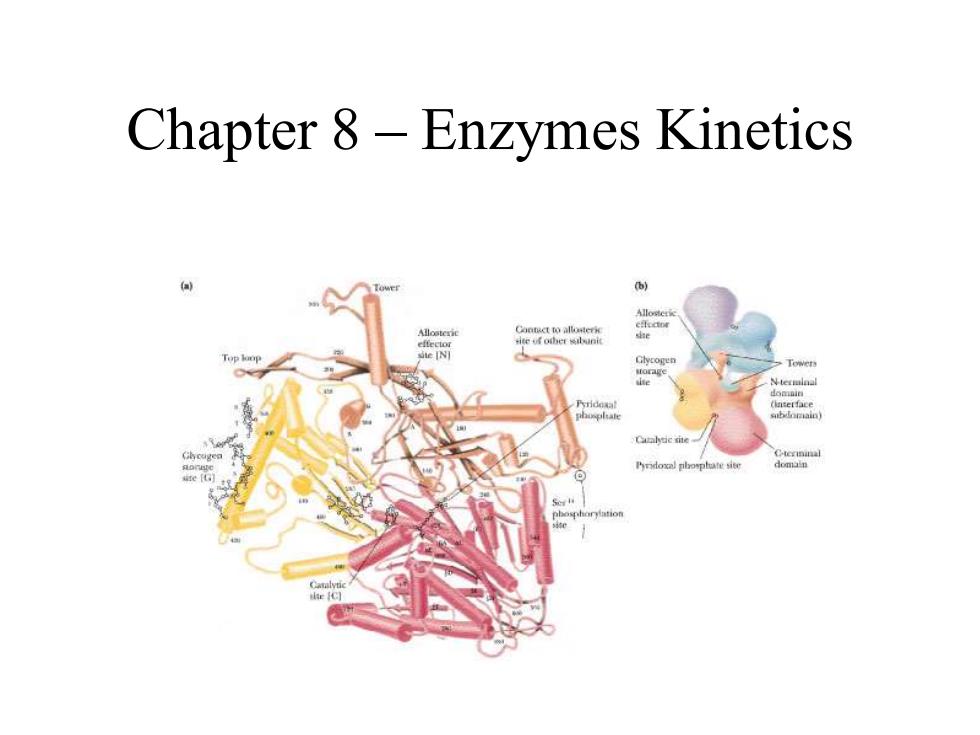
Chapter 8-Enzymes Kinetics Contact to allorteric ite of ofer bni
Chapter 8 – Enzymes Kinetics
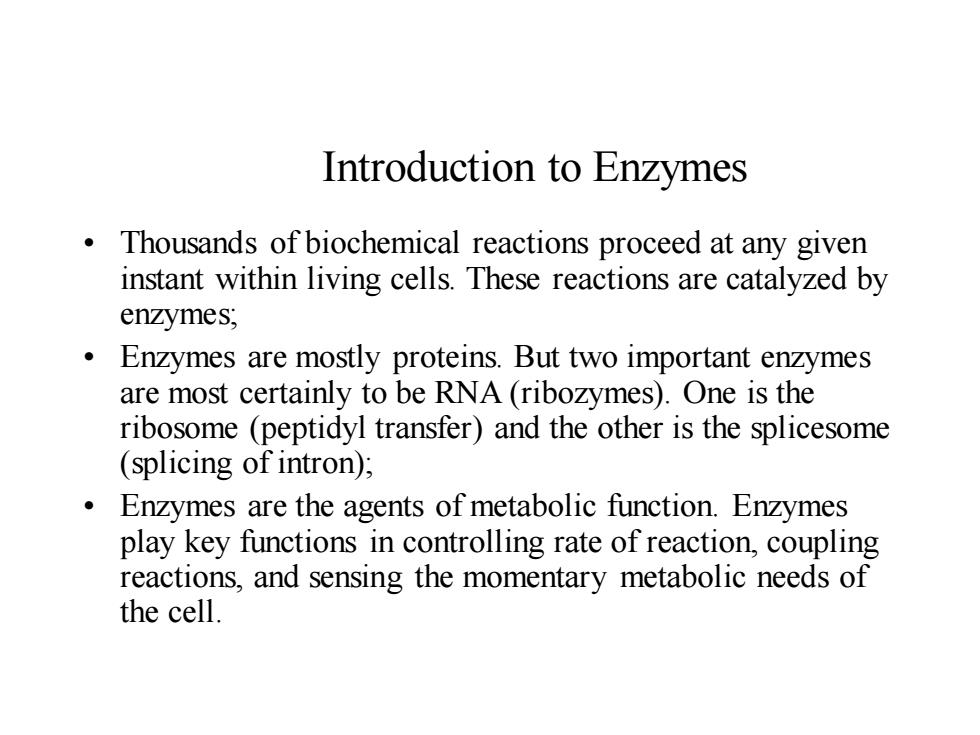
Introduction to Enzymes Thousands of biochemical reactions proceed at any given instant within living cells.These reactions are catalyzed by en☑ymes, Enzymes are mostly proteins.But two important enzymes are most certainly to be RNA(ribozymes).One is the ribosome (peptidyl transfer)and the other is the splicesome (splicing of intron); Enzymes are the agents of metabolic function.Enzymes play key functions in controlling rate of reaction,coupling reactions,and sensing the momentary metabolic needs of the cell
Introduction to Enzymes • Thousands of biochemical reactions proceed at any given instant within living cells. These reactions are catalyzed by enzymes; • Enzymes are mostly proteins. But two important enzymes are most certainly to be RNA (ribozymes). One is the ribosome (peptidyl transfer) and the other is the splicesome (splicing of intron); • Enzymes are the agents of metabolic function. Enzymes play key functions in controlling rate of reaction, coupling reactions, and sensing the momentary metabolic needs of the cell
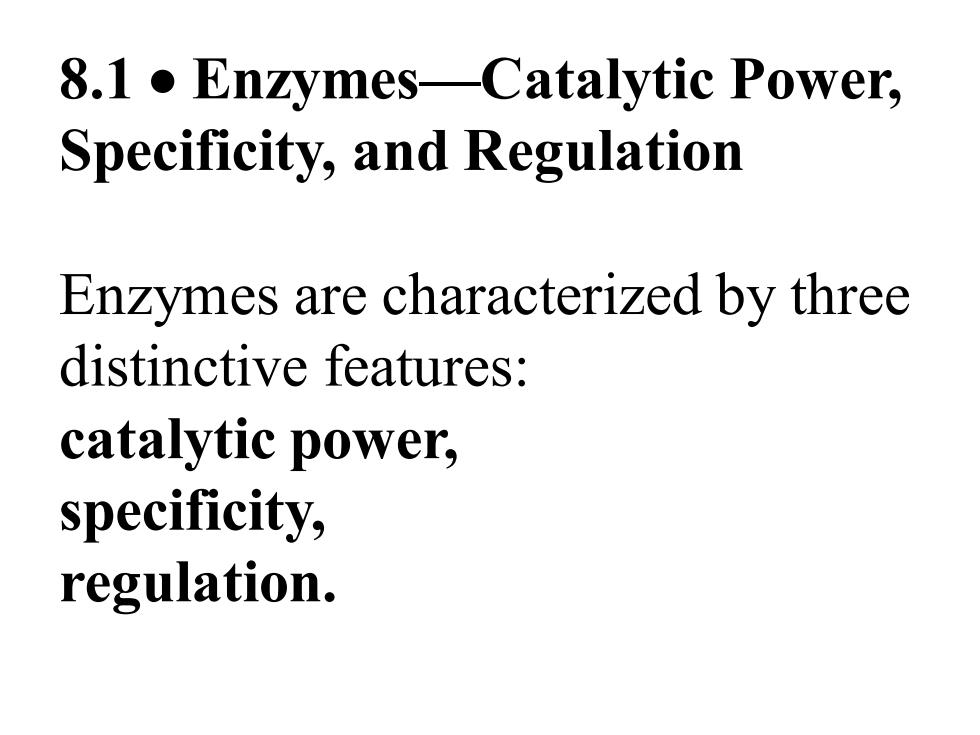
8.1.Enzymes-Catalytic Power, Specificity,and Regulation Enzymes are characterized by three distinctive features: catalytic power, specificity, regulation
8.1 • Enzymes—Catalytic Power, Specificity, and Regulation Enzymes are characterized by three distinctive features: catalytic power, specificity, regulation
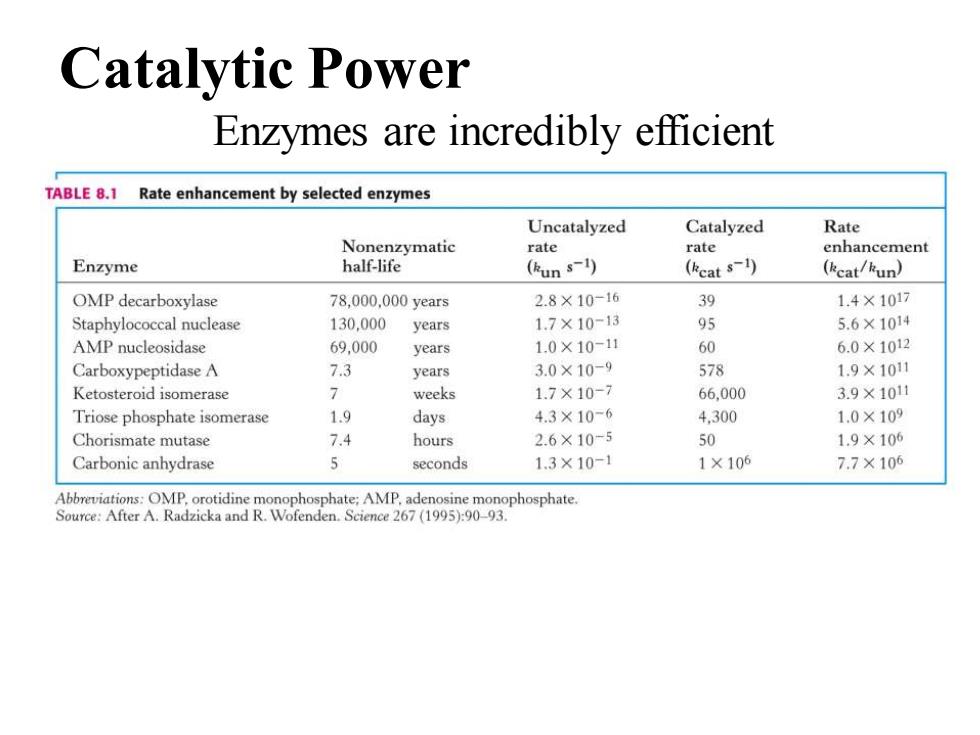
Catalytic Power Enzymes are incredibly efficient TABLE 8.1 Rate enhancement by selected enzymes Uncatalyzed Catalyzed Rate Nonenzymatic rate rate enhancement Enzyme half-life (kun s-1) (kcat s-1) (kcat/kun) OMP decarboxylase 78,000,000 years 2.8×10-16 39 1,4×1017 Staphylococcal nuclease 130.000 years 1.7×10-13 95 5.6×1014 AMP nucleosidase 69,000 years 1.0×10-11 60 6.0×1012 Carboxypeptidase A 7.3 years 3.0×10-9 578 1.9×1010 Ketosteroid isomerase 7 weeks 1.7×10-7 66,000 3.9×10日 Triose phosphate isomerase 1.9 days 4.3×10-6 4,300 1.0×109 Chorismate mutase 7.4 hours 2.6×10-5 50 1.9×106 Carbonic anhydrase seconds 1.3×10-1 1×106 7.7×106 Abbreviations:OMP,orotidine monophosphate:AMP.adenosine monophosphate. Source:After A.Radzicka and R.Wofenden.Science 267 (1995):90-93
Enzymes are incredibly efficient Catalytic Power
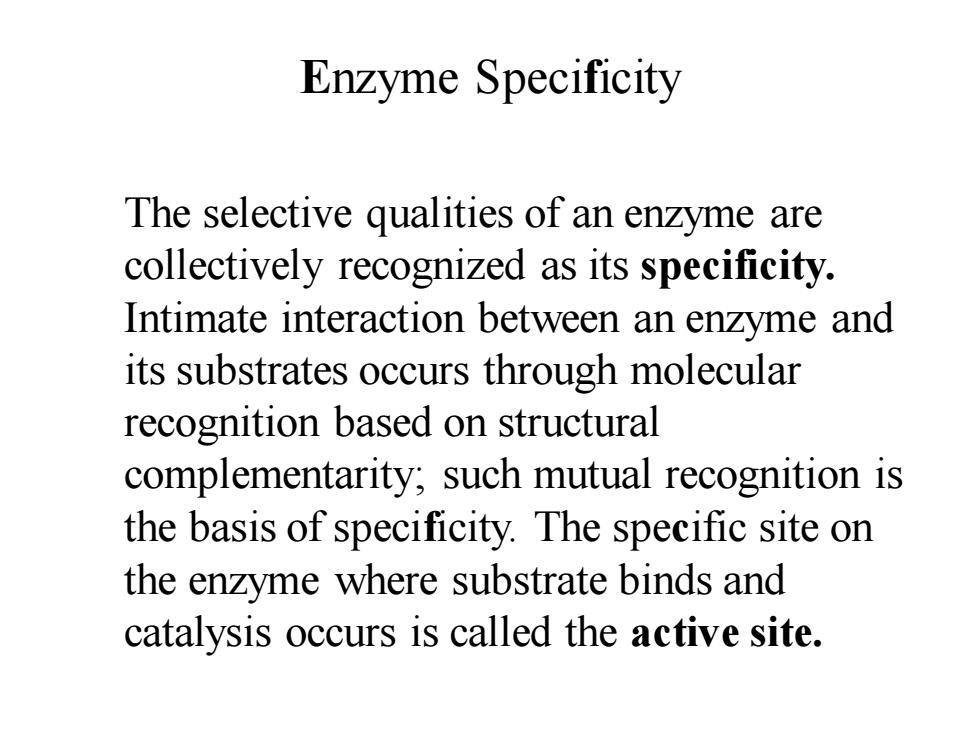
Enzyme Specificity The selective qualities of an enzyme are collectively recognized as its specificity. Intimate interaction between an enzyme and its substrates occurs through molecular recognition based on structural complementarity;such mutual recognition is the basis of specificity.The specific site on the enzyme where substrate binds and catalysis occurs is called the active site
Enzyme Specificity The selective qualities of an enzyme are collectively recognized as its specificity. Intimate interaction between an enzyme and its substrates occurs through molecular recognition based on structural complementarity; such mutual recognition is the basis of specificity. The specific site on the enzyme where substrate binds and catalysis occurs is called the active site
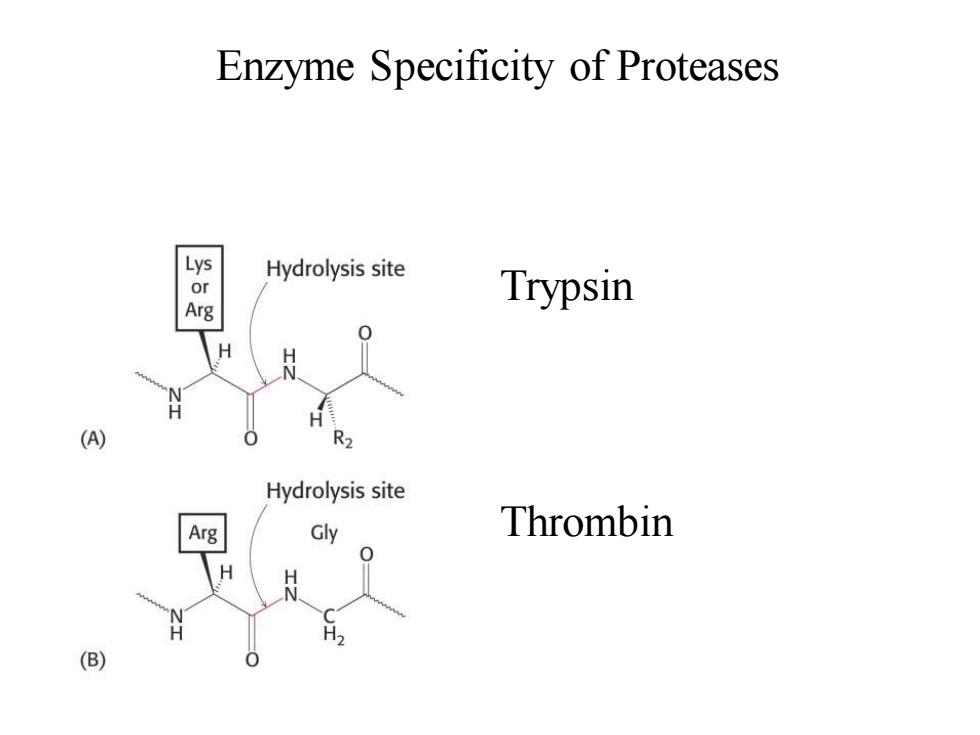
Enzyme Specificity of Proteases Or Hydrolysis site Trypsin Arg H (A) Hydrolysis site Arg Gly Thrombin H (B)
Enzyme Specificity of Proteases Trypsin Thrombin

Regulation Regulation of enzyme activity is achieved in a variety of ways,ranging from controls over the amount of enzyme protein produced by the cell to more rapid,reversible interactions of the enzyme with metabolic inhibitors and activators. Next chapter is devoted to discussions of enzyme regulation.Because most enzymes are proteins, we can anticipate that the functional attributes of enzymes are due to the remarkable versatility found in protein structures
Regulation Regulation of enzyme activity is achieved in a variety of ways, ranging from controls over the amount of enzyme protein produced by the cell to more rapid, reversible interactions of the enzyme with metabolic inhibitors and activators. Next chapter is devoted to discussions of enzyme regulation. Because most enzymes are proteins, we can anticipate that the functional attributes of enzymes are due to the remarkable versatility found in protein structures
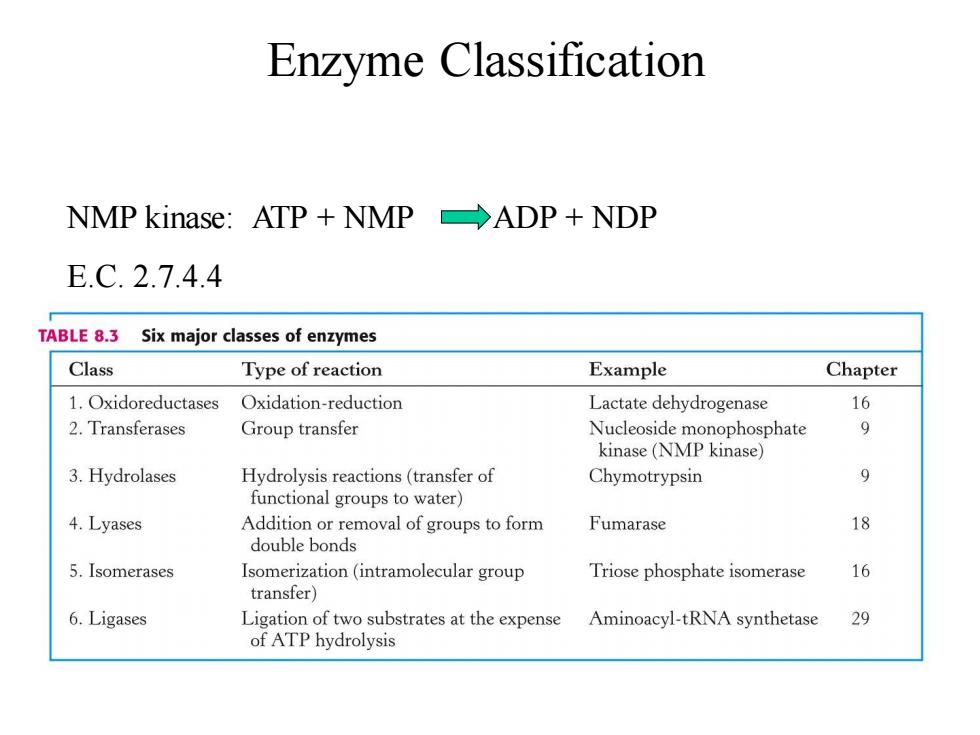
Enzyme Classification NMP kinase:ATP NMP ADP NDP E.C.2.7.4.4 TABLE 8.3 Six major classes of enzymes Class Type of reaction Example Chapter 1.Oxidoreductases Oxidation-reduction Lactate dehydrogenase 16 2.Transferases Group transfer Nucleoside monophosphate kinase(NMP kinase) 3.Hydrolases Hydrolysis reactions(transfer of Chymotrypsin functional groups to water) 4.Lyases Addition or removal of groups to form Fumarase 18 double bonds 5.Isomerases Isomerization(intramolecular group Triose phosphate isomerase 16 transfer) 6.Ligases Ligation of two substrates at the expense Aminoacyl-tRNA synthetase 29 of ATP hydrolysis
Enzyme Classification NMP kinase: ATP + NMP ADP + NDP E.C. 2.7.4.4
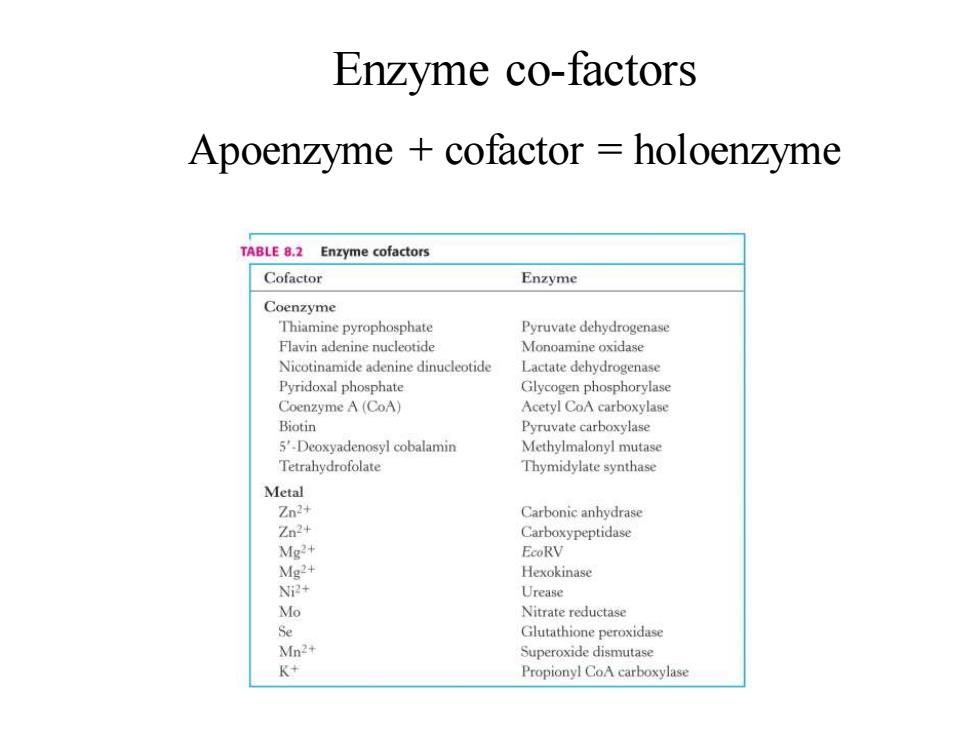
Enzyme co-factors Apoenzyme cofactor holoenzyme TABLE 8.2 Enzyme cofactors Cofactor Enzyme Coenzyme Thiamine pyrophosphate Pyruvate dehydrogenase Flavin adenine nucleotide Monoamine oxidase Nicotinamide adenine dinucleotide Lactate dehydrogenase Pyridoxal phosphate Glycogen phosphorylase Coenzyme A(CoA) Acetyl CoA carboxylase Biotin Pyruvate carboxylase 5'-Deoxyadenosyl cobalamin Methylmalonyl mutase Tetrahydrofolate Thymidylate synthase Metal Zn2+ Carbonic anhydrase Zn2+ Carboxypeptidase Mg2+ EcoRV Mg2+ Hexokinase Ni2+ Urease o Nitrate reductase Glutathione peroxidase Mn2+ Superoxide dismutase K+ Propionyl CoA carboxylase
Enzyme co-factors Apoenzyme + cofactor = holoenzyme

Cofactor (Coenzyme and Prosthetic Group) In most cases,a coenzyme is firmly associated with its enzyme,perhaps even by covalent bonds, and it is difficult to separate the two.Such tightly bound coenzymes are referred to as prosthetic groups of the enzyme.The catalytically active complex of protein and prosthetic group is called the holoenzyme.The protein without the prosthetic group is called the apoenzyme;it is catalytically inactive
Cofactor (Coenzyme and Prosthetic Group) In most cases, a coenzyme is firmly associated with its enzyme, perhaps even by covalent bonds, and it is difficult to separate the two. Such tightly bound coenzymes are referred to as prosthetic groups of the enzyme. The catalytically active complex of protein and prosthetic group is called the holoenzyme. The protein without the prosthetic group is called the apoenzyme; it is catalytically inactive